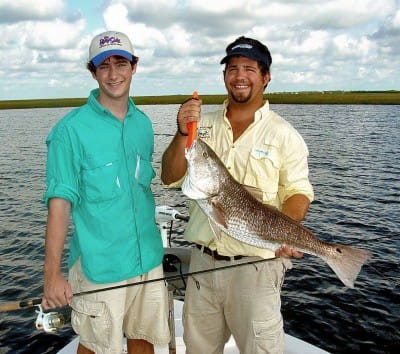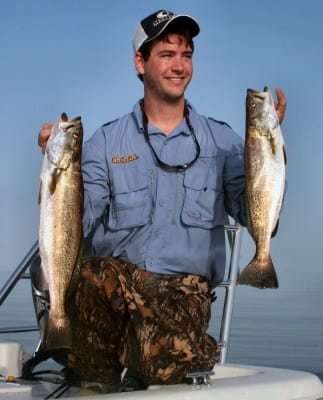
“You shoulda been here yesterday!”
That’s an old, worn fisherman’s quip. It’s also the tongue-in-cheek motto of guides working out of Hackberry Rod and Gun Club on sprawling Lake Calcasieu in southwest Louisiana. They even jokingly wear the motto on their lodge logo hats and fishing shirts.
But right then, at that moment, we were living “yesterday.”
“I’m glad I’m here, today, this afternoon….now!,” laughed my oldest son Eric while holding a bent-double spinning rod, with a hard-fighting seatrout on the other end. “Beause it couldn’t possibly have been any better than this!”
“Oh, but it was better yesterday,” said guide Kirk Stansel, who was battling an even bigger seatrout on baitcasting tackle. “Yesterday, in three hours, four of us caught 47 speckled trout averaging 2 1/2 pounds, in just three hours fishing.”
“Yeah, but how many big fish did you get?” countered Eric as he netted his 4-pound spotted fish.
“We had four fish over 5 pounds, biggest about 6 pounds, answered Kirk.”
“Uh-huh, well that one you just boated is our 24th, and that makes three trout each weighing over 6 pounds today, best 6 1/2!”
“I’ll take today over yesterday,” my other son Matt chimed in to team up with Eric in the battle of the better trout days on Calcasieu. “I’ve got another big one on here.”
The day was fading, but the fishing action was staying red hot at the north end of Lake Calcasieu. But we called it quits soon thereafter, as we had to be up early the next morning to head back home in Florida.
We’d driven over to visit Kirk, who runs Hackberry Rod and Gun Club, in the town of Hackberry, on the shores of the 18-mile long, 6-mile wide inland sea called Lake Calcasieu. I’ve fished the lake often over the years with Kirk and he wanted me to bring my sons, as the fishing had been great.
“Our seatrout and red drum fishing has gotten unbelievably good since Louisiana declared both species sportfish, and gill netting has been almost completely outlawed in Lake Calcasieu [only for mullet during a fall season]. Within a very short time our numbers of trout and redfish increased many fold, and the sizes. They’ve gotten unreal.”
So out we went that first afternoon with Kirk, and the catch was mind shattering. Our catch of 47 seatrout averaging 2 1/2 pounds would have made every newspaper in my home state of Florida if it had been caught in the Sunshine State. The next morning, four of us boated 28 trout, averaging over 3 pounds, with eight fish over 6 pounds, in less than three hours. That was some of the best big spotted seatrout action I’ve experienced in over 30 years of casting for the species.
“Yeah, we had good fishing, but it can be a lot better,” explained Kirk one night back at the lodge. “Spring is best for really big seatrout. April, May and June are sensational. Summer and fall are good, too, but spring is something else for heavyweight specks.”
We returned in May, and Kirk was right.
With my son Eric, and friend Jake Markris, fishing with Kirk, we caught many dozens of trout, and plenty of big ones. We also landed a number of redfish, and a surprisingly large number of flounder, something I’d never experienced previously on Calcasieu.
“With the nets out of Calcasieu, the size of our fish and the numbers have gotten unreal,” explained Kirk Stansel. “Before the net ban a big trout from the lake was a 7-pounder, now we class a big fish as 9 pounds. And the average size trout has jumped from just over 1 pound to a solid 2 pounds. And it can only get better, because the nets aren’t coming back.”
Kirk says April, May and June are best for Calcasieu giant trout. But through the summer, into fall, also is great. One summer day a large group of guides working out of Hackberry Rod and Gun Club had a mini-tournament for trout, strictly for club bragging rights. There were four anglers per boat, with a 20 fish per boat bag limit. Kirk and his fishing team won the day’s event with 20 fish weighing 78.6 pounds—-nearly a 4-pound average! His brother, Bobby, had 68 pounds, another guide Mark Huser had 62 pounds. Lowest team still had a limit of 20 trout, weighing 42 pounds—-better than a 2-pound average, in July!

Calcasieu is giving up big trout in unprecedented numbers no doubt due to the net ban. Fishing has improved dramatically, and quickly, because the lake is an immense nursery area for inshore marine life. Surrounding much of the lake are many miles of pristine salt marsh, much of it in the Sabine Wildlife Refuge, which allows no fishing. It is a huge breeding area for shrimp and baitfish, with a close proximity to the open Gulf of Mexico. Calcasieu also is mostly shallow, making it fertile. Just as important, there is a 50-foot deep, man-made ship channel running through the lake’s center for freighters to reach Lake Charles from the Gulf of Mexico. The deep-water channel is a stable water temperature sanctuary for fish when the lake becomes too hot in summer, too cold in winter. Thus die-offs of bait and fish are rare, and gamefish are available 12 months per year.
A good case can be made that Lake Calcasieu offers some of America’s best fishing for heavyweight spotted seatrout, as well as redfish. Anglers working from a boat can expect to catch up to 100 trout per day on Calcasieu (most are released). Fish average nearly 2 pounds, and bruisers over 5 pounds are taken regularly. Plus, lots of trout in the 8- to 10-pound class are recorded. Moreover, action from hard-fighting red drum and flounder occur regularly almost every day on the lake.
Kirk keeps close tabs on the numbers and sizes of fish brought in by the lodge guide boats that daily leave Hackberry Rod and Gun Club. One year guide boats (two anglers, one guide) caught 68.7 fish per boat, per day. During the prime spring season, an average of 500 trout each weighing over 6 pounds were caught every month by club anglers. That year the catch tally was over 200,000 fish by Hackberry Club anglers, though most were released!
Those numbers tell it all. I’ll vouch for their authenticity.
When To Go
While fishing on Lake Calcasieu can be excellent year-round, there are peaks and valleys to the action, primarily because weather and water conditions make successful angling difficult. Following is a guide to the Big Lake.
January through March: Good for seatrout, when the weather cooperates. Trouble is wind, which muddies water. On days when it’s clear, bright, calm and warm, great fishing is available. Combination waterfowl hunting (a.m.), trout fishing (p.m.) can be done.
April through June: This is the best and most consistent time for big seatrout 8 and 10 pounders are possible. High winds can be a problem early in this phase, but when it’s right, it’s sensational.
July through September: The most consistent trout time of the year, though spawning-size mega-seatrout are not as common as spring. Great average-size seatrout, and big catches of schooling fish are made under diving birds. 100 fish days are common.
October through December: Perhaps the best time for multi-species: seatrout, redfish, flounder. Lots of good-size fish are caught, trout to 8 pounds, reds to 12 pounds, and flounder to 5 pounds. In fall, waterfowl combo hunts also can be made with fishing.
The Union Sportsmen’s Alliance website is designed to provide valuable articles about hunting, fishing and conservation for members of AFL-CIO affiliated labor unions and all sportsmen and sportswomen who appreciate hunting and fishing and want to preserve our outdoor heritage for future generations. If you would like your own story and experience from the outdoors to be considered for our website, please email us atUSAmembers@unionsportsmen.org.



